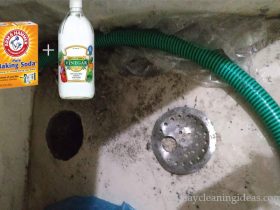No one likes the sight of stubborn stains on clothes. If you are wondering if using rubbing alcohol to remove stains will leave stains or not, then this article is for you. While I know and personally believe in the magic of rubbing alcohol, on the flip side, it can leave stains behind or worse, can bleach clothes.
In this article, I will explain the nature of rubbing alcohol, its differences from isopropyl alcohol, and the reasons behind its stain-causing potential.
To make things easier for you, I will also suggest effective ways to remove rubbing alcohol stains while discussing how to counteract the bleached effects they might leave behind.
Additionally, I have also outlined safety measures for using rubbing alcohol and provided alternatives that can be used instead of rubbing alcohol.
What is Rubbing Alcohol and Why Does It Leave a Stain?
Rubbing alcohol, also known as isopropyl alcohol, is a colorless, volatile liquid typically used for medical, cleaning, and disinfecting purposes. It contains isopropanol, which evaporates quickly, leaving a clean and sanitized surface.
However, its staining potential arises from the other ingredients commonly found in commercial rubbing alcohol preparations, such as colorants, fragrances, and stabilizers. When these components come into contact with fabrics, they can leave behind noticeable stains.
How is Rubbing Alcohol Different from Isopropyl Alcohol
Before I dive deeper into the staining issue, it’s vital to clarify the distinction between rubbing alcohol and pure isopropyl alcohol. Pure isopropyl alcohol, typically used for industrial purposes, is less likely to contain the additives that can cause stains.
Isopropyl alcohol can be effective in removing certain types of stains, particularly ink, grease, and some types of food stains. Its ability to dissolve or break down these substances can make it useful for stain removal. However, its effectiveness may vary depending on the type of fabric and the specific stain.
It’s important to note that while isopropyl alcohol can be useful for some stain removal tasks, it may not be the best solution for all stains. In some cases, using specialized stain removers or following specific stain removal methods for different types of stains may yield better results.
In contrast, rubbing alcohol is a diluted form of isopropyl alcohol, often with additional ingredients that increase its likelihood of staining fabrics. Rubbing alcohol additives are the real culprit behind the stains.
Ultimately, whether isopropyl alcohol or rubbing alcohol is better for stain removal depends on the specific stain, fabric type, and individual circumstances.
Rubbing Alcohol and its Impact on Different Fabrics
Rubbing alcohol is bound to react differently according to the composition of every fabric. Different types of fabrics have varying levels of resistance to rubbing alcohol, and some may be more appropriate than others for removing stains. Here’s a breakdown of common fabric types and their compatibility with rubbing alcohol:
- Cotton:
-
- It is generally more resistant to staining from rubbing alcohol compared to delicate fabrics like silk.
- However, the risk of staining can increase if the rubbing alcohol contains additional additives, such as dyes or fragrances.
- To minimize the risk of staining, it’s essential to apply rubbing alcohol sparingly, blot rather than rub, and rinse the fabric with cold water promptly if any staining occurs.
- Linen:
-
- Linen is somewhat similar to cotton in terms of resistance to rubbing alcohol staining.
- The risk of staining can still exist, especially if the rubbing alcohol contains additives or if the fabric is delicate.
- As with cotton, use rubbing alcohol carefully and rinse with cold water if needed.
- Silk:
-
- It is a delicate and sensitive fabric that can be easily damaged or stained by rubbing alcohol.
- The risk of staining, discoloration, or damage is relatively high when using rubbing alcohol on silk.
- It’s crucial to perform a spot test on an inconspicuous area before using rubbing alcohol on silk. If the fabric reacts negatively, do not proceed with the application.
- Synthetic Fabrics (Polyester, Nylon, etc.):
-
- Synthetic fabrics like polyester and nylon are generally more resistant to staining from rubbing alcohol.
- These fabrics are often used in commercial cleaning applications where rubbing alcohol is used as a disinfectant or cleaner.
- However, some synthetic fabrics may still be sensitive to certain rubbing alcohol formulations, so it’s advisable to perform a spot test if in doubt.
- Wool:
-
- Wool is relatively sensitive to rubbing alcohol and can be more prone to staining and damage.
- Avoid using rubbing alcohol on wool fabrics unless you’ve tested it in an inconspicuous area first and are confident it won’t cause harm.
In all cases, it’s crucial to exercise caution when using rubbing alcohol on fabrics. It can be concluded that cotton, microfiber, and synthetic fabrics are typically the best choices for tasks involving rubbing alcohol, as they are durable and less likely to be damaged or stained.
How to Remove Rubbing Alcohol Stains
I know dealing with rubbing alcohol stains can be frustrating. Worry not! Because every problem has a solution. Here are some effective ways to make stain removal easier:
- Act Quickly
The sooner you address the stain, the better your chances of successful removal. Blot the stain gently to soak up excess liquid, be careful not to rub it deeper into the fabric.
- Check Fabric Care Label
Examine the care label on your clothing to determine the appropriate cleaning method. Different fabrics require different treatments.
- Test a Hidden Area
Before applying any cleaning solution, you should always run a patch test on an inconspicuous area of the fabric to ensure it doesn’t cause further or irreversible damage.
- Pre-treat the Stain
Dab a small amount of a mild detergent or rubbing alcohol (ironically) on the stain. Allow it to sit for a few minutes. Do not scrub the area vigorously!
- Rinse and Wash
Rinse the stained area with cold water and then launder the garment as usual, following the care instructions. Use cold water for the wash to prevent setting the stain.
- Air Dry
Avoid using a dryer until you’re sure the stain is completely gone. This is because heat can set the stain permanently.
How to Undo Bleached Stains Caused by Rubbing Alcohol
As I have already hinted before, sometimes, rubbing alcohol can not only leave stains but also bleach the fabric, leaving white or discolored marks. Follow this step-by-step guide to deal with the issue:
- Dilute the Bleached Area
Mix equal parts of water and vinegar or lemon juice and gently apply the solution to the bleached area. Allow it to sit for a few minutes.
- Rinse and Launder
Rinse the treated area with cold water and launder the garment as usual, using a color-safe detergent. You should avoid using chlorine bleach.
- Assess the Results
After washing, check if the bleached area has improved. Repeat the process if necessary to achieve the desired result.
How to Use Rubbing Alcohol Correctly
While rubbing alcohol is an excellent cleaning agent, it can often leave stains or even bleach/decolor your clothes. So to minimize the risk of staining and to ensure the safe usage of rubbing alcohol, follow these precautions:
- Spot Test
As mentioned before, you should always perform a spot test on a hidden area of the fabric to check for any adverse reactions.
- Dilution
If possible, use pure isopropyl alcohol for tasks that involve contact with fabrics, as it contains fewer additives that can cause stains.
- Use Sparingly
Apply rubbing alcohol sparingly and avoid soaking fabrics in it unnecessarily.
- Immediate Treatment
If rubbing alcohol accidentally spills on clothing, treat the stain promptly following the steps mentioned earlier.
- Ventilation
Use rubbing alcohol in well-ventilated areas to minimize inhalation of fumes.
- Safety Gear
When using rubbing alcohol for cleaning or disinfection, wear gloves and eye protection to protect your skin and eyes.
Other Alternatives of Rubbing Alcohol
Seeing that rubbing alcohol can be a little tricky to use, many people ask for alternative options instead of rubbing alcohol. If you’d rather avoid the potential for staining altogether, consider these alternatives:
1. Hydrogen Peroxide
Hydrogen peroxide (H2O2) is a versatile and widely available disinfectant and cleaning agent that can be used as a safer alternative to rubbing alcohol when it comes to avoiding stains on clothing and fabrics. There are several advantages of using hydrogen peroxide when it comes to effective stain removal-
- Stain Resistance
Unlike rubbing alcohol, hydrogen peroxide is less likely to leave stains on fabrics. It breaks down into water and oxygen upon contact with organic matter, reducing the risk of discoloration.
- Household Cleaning
You can use hydrogen peroxide to clean surfaces in your home, including kitchen counters, bathroom tiles, and glass surfaces.
- Grades
Hydrogen peroxide is available in various concentrations, so be sure to choose the appropriate strength for your intended use. For medical purposes, a 3% solution is typically used.
2. Vinegar
White vinegar is another effective alternative to rubbing alcohol and is widely available in every household. It is known for its cleaning and disinfecting properties and is less likely to stain fabrics.
- Stain Resistance
Vinegar is generally safe to use on most fabrics and is less likely to cause staining compared to rubbing alcohol.
- Deodorizing
Vinegar can neutralize and eliminate unpleasant odors, making it useful for deodorizing items like shoes or pet bedding.
- Natural Cleaning
It’s an eco-friendly and non-toxic cleaning agent that can be used in various household cleaning tasks, such as cleaning glass, countertops, and bathroom fixtures.
3. Commercial Disinfectant Wipes
For those who prefer ready-made solutions that are convenient and designed specifically for disinfection, commercial disinfectant wipes are an excellent alternative to rubbing alcohol.
- Convenience
Disinfectant wipes are pre-soaked in a disinfecting solution, making them convenient for quick and easy cleaning of surfaces, electronics, and frequently touched objects.
- Stain-Free
These wipes are formulated to minimize the risk of staining, so you can confidently use them on a variety of surfaces, including fabrics.
- Portability
Disinfectant wipes are available in portable packaging, making them ideal for on-the-go use, such as in public places or while traveling.
- Variety
There are various brands and types of disinfectant wipes available, including those with specific scents or for specialized purposes, such as electronics cleaning.
Conclusion
Rubbing alcohol can indeed leave stains on clothes due to the additives commonly found in commercial preparations. Understanding the difference between rubbing alcohol and pure isopropyl alcohol, as well as following proper stain removal and safety measures, can help mitigate this issue.
With the right knowledge and precautions, you can continue to benefit from the versatility of rubbing alcohol while safeguarding your clothing from unsightly stains. I hope this article was worth your time to know all the secrets behind fabric care and stain prevention.
Read here –









Leave a Reply
View Comments